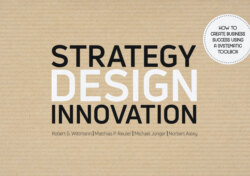Читать книгу Strategy Design Innovation - Robert G. Wittmann - Страница 7
На сайте Литреса книга снята с продажи.
ОглавлениеChapter 1
DYNAMICS IN THE BUSINESS WORLD AND THE APPROACH OF THE BOOK
Executives are facing considerable new challenges in a so-called VUCA world, where volatility, uncertainty, complexity and ambiguity set the future pace of competition. In such an environment executives need to understand how to make use of short-lived opportunities, quickly and decisively. The acronym VUCA was originally introduced by the U.S. Army War College to describe the dynamics and the strategic impact of today‘s multilateral world. The elements of VUCA pinpoint the strategic significance of foresight and insight, as well as the insight into the behavior of stakeholders, groups and individuals, outside and inside organizations. The following elements represent the context in which organizations in the field of business view their current and future state:
— V > Volatility: addresses the nature of change and the dynamics of those forces and catalysts causing the change. As a consequence external change may be faster than the organization‘s ability to respond.
— U > Uncertainty: describes the lack of predictability and the prospects for sudden surprise. Here the leadership challenge is the requirement to develop a sense of awareness and the ability to anticipate and interpret issues and events effectively.
— C > Complexity: indicates the variety of forces influencing an organization and its ability to survive. Multiplex issues and missing understanding of cause-and-effect chains may lead to confusion. Leaders may be lacking the time to reflect and think through these complexities. They end up acting too quickly or getting stuck in analytic paralysis. And, consequently, they may be acting too late.
— A > Ambiguity: addresses the haziness of reality and the resulting potential for misreads and confusion. Leaders may not understand the significance of a trend or an event and may respond in an ineffective way.
Johansen (2012) points out that in an uncertain world there is urgent need for a future paradigm of leadership, turning the original VUCA idea on its head:
— The threats of volatility can be countered by a clear vision causing a light-house effect for the navigation in turbulent times.
— Uncertainty can be countered by a deep and solid understanding of the developments in the business environment using the ability to listen, to look, to perceive and to understand what makes the environment tick.
— Complexity can be countered by clarity and the ability to think in networks and systemic cause-and-effect patterns.
— Ambiguity can be countered by agility, the ability to communicate, to share paradigms for better understanding, to exploit short-lived opportunities. It is crucial to keep pace with the respective market speed.
Abidi and Joshi (2015) draw the conclusion that there is a need for resilient leadership skills, comprising engagement themes in planning, knowledge management, impact models, recovery systems and perception systems for behavioural and systemic failure detection.
McGrath (2013) shows that some of the traditional paradigms of strategic business development no longer continue to exist. A set of future paradigms has to be developed to keep the strategy moving as fast as the VUCA world requires. In these future-oriented paradigms the understanding of competitive advantages has to recognize that advantages are not sustainable, but transient, on rather short notice. Because of this need for agility the approaches of strategy and innovation – formerly separate disciplines – now have to be interlinked. The understanding of market attractiveness and the relevant competition are shifting from the traditional industry focus to competitive “arenas”. This is where the real threats and opportunities happen between industries, caused by functional substitution rather than by product substitution and by competitive business models. The rules of the game are becoming more important than compelling product offers.
Table 1.1 lists the changing paradigms for leadership. It shows that the future paradigms from the VUCA world have considerable influence on the way companies have to manage strategy and innovation in their competitive arenas. The approach of Strategy Design Innovation is inspired by these future paradigms.
Table 1.1 Volatility, uncertainty, complexity and ambiguity create a VUCA world – changing the paradigms for leadership. ▼
| Aspect of Strategy Design | Traditional paradigm | Future paradigm |
| Idea of competitive advantage | Presumption of relative stability in industry competition → competitive advantages can be sustainable | Uncertainty, volatility, complexity and ambiguity lead to transient competitive advantages |
| Relation between strategy and innovation | Two separate disciplines: finding favorable positions in a well defined industry by strategy and creating new business by innovation | Combining strategy and innovation into one discipline in order to keep pace with the speed of markets |
| Emphasis on strategy | Focus on analyzing industries and achieving sustainable competitive advantage | Focus on transient competitive advantages by exploiting short lived opportunities with speed and decisiveness |
| Competition | Competition within the industry and its forces matters most | Competition in arenas of market segments, offers and geographical location, as well as between industries |
| Customer advantages | Advantages created by product economics | Advantages created by customer oriented solutions and lock-in approaches |
Further reading:
Abidi, S. / Joshi, M.: The VUCA company, How Indian Companies have faced Volatility, Uncertainty, Complexity & Ambiguity, Mumbay 2015. Hax, A. / Wilde, D.: The Delta Project: Discovering New Sources of Profitability in a Networked Economy, New York 2011.
McGrath, R.G.: The end of competitive advantage: how to keep your strategy moving as fast as your business, Boston 2013.
Johansen. B.: Leaders Make the Future: Ten New Leadership Skills for an Uncertain World, San Francisco 2012.
